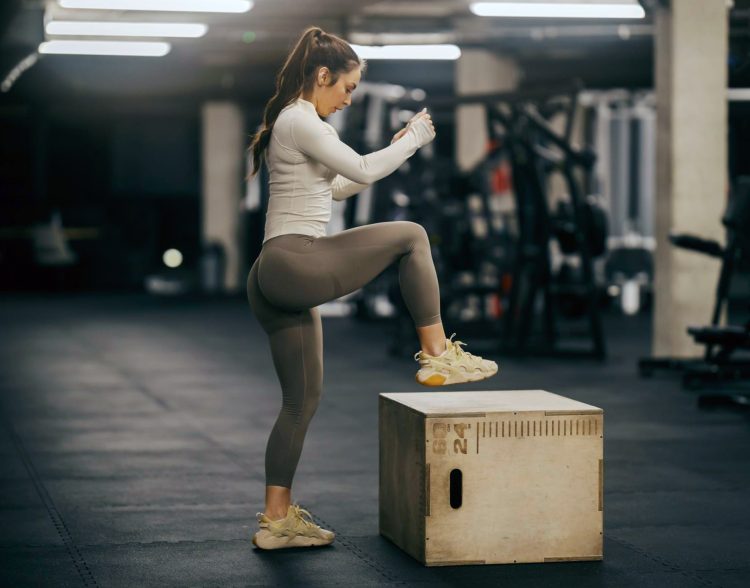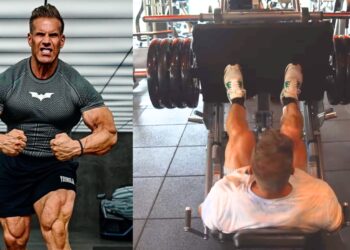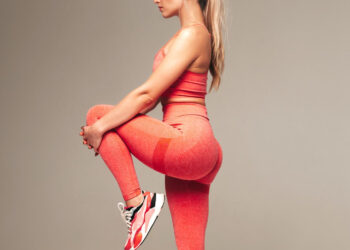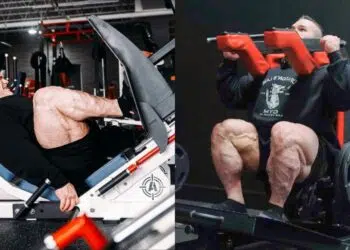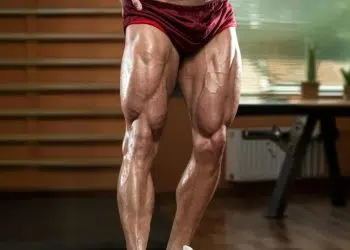If you want a great-looking body, you’ve got to train your legs. As a veteran personal trainer with over three decades of professional experience, I don’t care if you are a man or a woman, young or old; a well-developed upper body paired with untrained legs looks unbalanced.
Sure, there are some people who cannot train their legs, maybe because of illness or injury. That said, if you can do exercises like squats, lunges, and leg presses, you should.
Leg training is hard but rewarding, and strong, muscular legs show your commitment to the fitness lifestyle. You don’t have to enjoy leg training, but you still need to do it!
But what if you train at home and don’t have access to a squat rack and leg press? Sorry, but that’s not an excuse for skipping leg day, either. There are plenty of low-tech but high-effect exercises you can do instead.
In this article, I take a detailed look at step-ups, one of the most underappreciated leg exercises around.
Why Do Step-Ups Instead of Leg Presses?
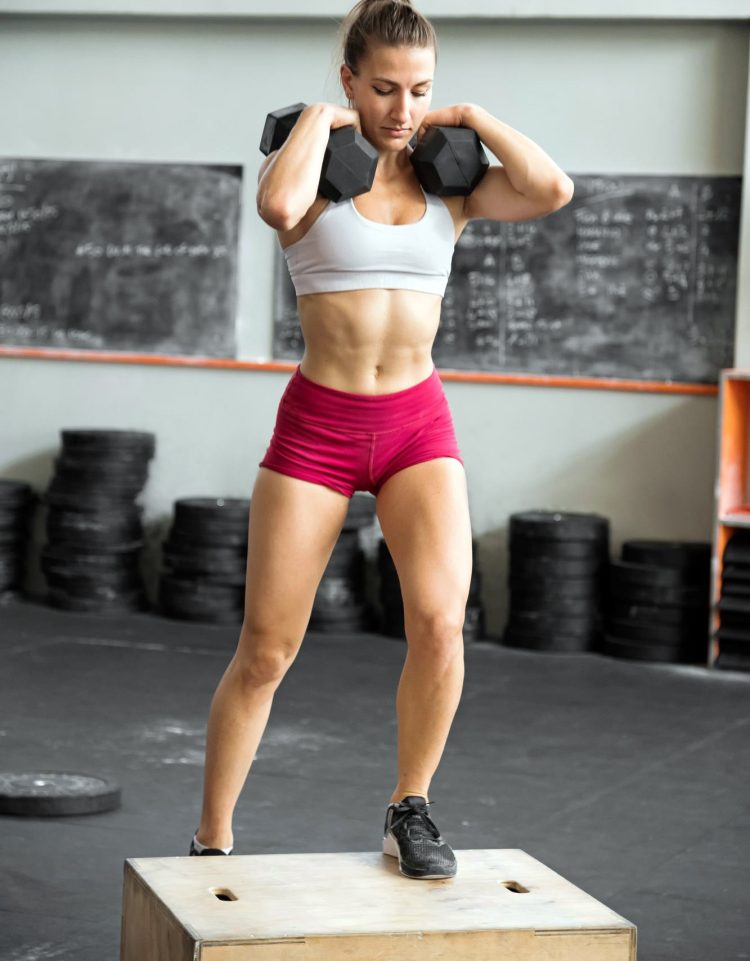
Level Up Your Fitness: Join our 💪 strong community in Fitness Volt Newsletter. Get daily inspiration, expert-backed workouts, nutrition tips, the latest in strength sports, and the support you need to reach your goals. Subscribe for free!
Leg presses are an effective exercise that you can use to build lower body strength and muscle mass (1). Many consider them safer than squats because they provide lots of back support. Additionally, the weight moves on rods, leaving you free to focus on pushing your muscles to their limit in relative safety.
However, there may be times when leg presses are impractical, and you need an alternative.
While they might not be your first choice, step-ups are a viable substitute for leg presses. Situations when step-ups may be better than leg presses include:
Related: 11 New Ways to Use the Leg Press Machine
No Leg Press Machine Available
Unless you have a state-of-the-art home or garage gym, you probably don’t have access to a leg press. There are compact leg press machines made for home use, but even they aren’t particularly small, and most are pretty expensive. The same is true for squat and power racks.
However, step-ups require minimal equipment, and you won’t need much space to do them. This means that step-ups are the perfect at-home, no-excuses leg workout.
To Identify and Fix Strength Imbalances
Leg presses are a bilateral exercise, meaning they work both legs at a time. While you should be pushing the weight with both legs equally, it’s normal to favor one leg. This can create left-to-right strength and muscle mass imbalances.
In contrast, step-ups are unilateral and work one leg at a time. This provides a convenient way to identify and fix imbalances.
Improved Functional Fitness and Strength
A functional exercise is one that enhances fitness and strength outside of the gym. This typically means that the exercise in question mimics or replicates commonly-performed movements.
While the leg press does a great job of strengthening the quadriceps, hamstrings, and glutes, it does so in a very non-functional way. After all, when was the last time you pressed a weight up with your legs while lying on your back?!
In contrast, step-ups involve a movement similar to walking, running, and climbing stairs. As such, it’s a much more functional exercise. So, if you want to build real-world strength and conditioning, the step-up is an excellent choice.
Better Balance and Coordination
Leg presses are a very straightforward exercise. Sit on the seat, put your feet on the footplate, and push – simple!
While such a conventional exercise means you can concentrate 100% on working your muscles to their limit, it’s less effective for stimulating your nervous system. As such, leg presses won’t do much for your balance and coordination.
Balance and coordination are neurological components of fitness. Balance is your ability to keep your center of mass over your base of support. In contrast, coordination is the ability to control and move your limbs accurately.
Step-ups are unsupported and unguided and will improve your balance and coordination more than leg presses. This is beneficial for all exercisers, especially athletes.
More Stable Knees and Hips
The agonists or prime movers in step-ups and leg presses are the same, with both exercises targeting your quadriceps, hamstrings, and gluteus maximus muscles. However, because the load travels on rods, leg presses don’t do much for the hip and knee stabilizers.
In contrast, step-ups involve more instability, so you must use your muscles to ensure your limbs follow the correct movement patterns. This increases activation of the gluteus minimus and medius, as well as the hip adductors. These muscles are less active during leg presses.
Increased knee and hip stability may help reduce your risk of injury, especially during sports and other physically demanding activities (2).
More Workout Variety
There is no denying that leg presses are an effective exercise, but doing them all the time can be boring. Bored exercisers are more likely to miss workouts and drop out of training altogether (3). Periodically replacing leg presses with step-ups is a great way to keep your training varied and interesting, making you less inclined to skip leg day.
Minimal Lower Back Stress
Despite the presence of a back support, leg presses can still put a lot of strain on your lumbar spine. Lowering the weight too far can cause a posterior pelvic tilt, which stresses the ligaments and disks of your lower back.
Level Up Your Fitness: Join our 💪 strong community in Fitness Volt Newsletter. Get daily inspiration, expert-backed workouts, nutrition tips, the latest in strength sports, and the support you need to reach your goals. Subscribe for free!
In contrast, step-ups involve a very upright posture, which puts minimal stress on your lumbar spine. As such, step-ups are often more lower back-friendly than leg presses. That’s good news if you are one of the many people who suffer from chronic lower back pain.
Good for Aging Exercisers
Getting older is an unfortunate but unavoidable fact of life. As you age, your muscles weaken, your balance decreases, and you are more prone to suffering falls. Falls are usually just an embarrassing inconvenience when you are younger, but they can cause severe injury as you get older. Broken hips are especially common and debilitating.
Step-ups are a proven way to improve walking ability and balance, lowering the risk of suffering a fall (4). As such, step-ups are an excellent option for aging exercisers.
While step-ups are a mostly beneficial exercise, there are also a few drawbacks to consider:
Access to an appropriate step
You’ll need a stable, strong platform for step-ups. Options include a plyo box, exercise bench, aerobic step, low wall, etc. Ideally, the step should be adjustable so you can do step-ups at the correct height. If you don’t have a suitable step, you may have to buy what you need or forgo this exercise.
Risk of tripping
Step-ups are a very safe exercise, but they aren’t 100% risk-free. There is a risk of tripping, especially when using weights or training close to failure. Losing your balance or your footing could result in severe injury.
Not ideal for heavy weights
While you can (and should) do weighted step-ups to make this exercise more challenging, they don’t work well with heavy weights. For example, holding hefty dumbbells could mean your grip tires before your legs. In contrast, step-ups with a barbell on your back mean you won’t have your arms for balance, increasing your risk of tripping.
So, while you can use step-ups to build endurance and muscle mass, they are not so useful for developing brute strength. Squats and leg presses are better exercises for this purpose.
Easy to cheat
Ideally, your lead leg should do almost all the work during step-ups. That’s the best way to challenge and develop the target muscles. However, it’s pretty easy to push off your trailing leg, taking work away from your lead leg. While such cheating may be unintentional, it will make this exercise easier and less effective.
How to Do Step-Ups
Get more from step-ups while keeping your risk of injury to a minimum by following these guidelines:
- Stand in front of a suitable platform. Ideally, it should be at least mid-shin height.
- Step up and place one foot on the top of the platform. Make sure your foot is flat and entirely on the platform to avoid slipping or tripping.
- Drive down through your heel and stand up on your platform. Bring your other foot up to meet it.
- Step down with the same leg and then switch sides.
- Continue alternating legs for the prescribed number of reps.
Pro tips:
- Use your trailing leg as little as possible. Try to do all the work with your leading leg.
- The higher the step, the more demanding this exercise becomes.
- Make this exercise harder by holding dumbbells or wearing a weighted vest.
- Lean forward slightly at the hips to increase glute and hamstring engagement.
- Do all your reps on one leg before switching sides if you prefer. This increases the overload on the working leg.
Step-Up Variations and Alternatives
Step-ups are a highly effective lower body exercise, but that doesn’t mean you need to do them all the time. Here are three variations and two alternatives you can use to keep your workouts productive and interesting:
1. Step-Up with Knee Raise
If you are more interested in cardiovascular fitness and fat-burning than building strength, this exercise is for you. Adding a knee raise puts more stress on your heart and lungs, making this variation more aerobically challenging. Do it with or without weights as preferred.
How to do it:
- Stand facing a sturdy platform that’s at least mid-shin height.
- Bend one leg and place your foot on top of your step.
- Drive down through your lead leg and step upward.
- Bring the knee of your trailing leg up until it’s level with your hips.
- Step back down the floor, switch legs, and repeat.
2. Lateral Step-Ups
The agonists in regular step-ups are the quadriceps, glutes, and hamstrings. The hip abductors and adductors are involved, but they only work as stabilizers. Lateral step-ups increase the load on these secondary muscles for a more balanced leg workout.
How to do it:
- Stand sideways onto your step.
- Bend your nearside leg and place your foot on the top of your platform.
- Drive down through your lead leg and step up, bringing your other foot up.
- Step down on the same side and repeat.
- Switch legs and do the same number of reps on the other side.
3. Plyometric Step-Ups
Power is your ability to generate force quickly. It’s a critical part of most sports and especially important for runners, kickers, jumpers, and throwers. Plyometric (plyo) step-ups are a moderately intense power exercise and an excellent progression from regular step-ups.
How to do it:
- Stand facing your step.
- Bend one leg and place your foot flat on the top of the platform.
- Drive your foot down hard and push yourself up and into the air. Use your arms for added momentum.
- Switch legs and land with your opposite foot on the step.
- Lower yourself back to the ground and repeat.
- Continue alternating legs for the required number of reps.
4. Alternating Lunge
While lunges don’t look a lot like step-ups, they actually involve the same muscles and a similar movement pattern. However, instead of stepping up, you just step forward. As such, lunges are the perfect alternative to step-ups when you don’t have access to a suitable platform.
How to do it:
- Stand with your feet together and your arms by your sides.
- Take a large step forward, bend your legs, and lower your rear knee down to within an inch of the floor.
- Push off your front leg and return to the starting position.
- Do your next rep with the opposite leg.
- Continue alternating sides for the prescribed number of reps.
5. Single-Leg Box Squats
You can make step-ups harder by using a higher box or holding weights. However, I know from experience that this is not always practical or possible. Single-leg box squats overload one leg at a time to deliver a more intense leg workout without weights. However, they’re much more accessible than true single-leg squats, i.e., pistols.
How to do it:
- Stand with your back to a box, bench, or step. The lower the platform, the more demanding this exercise becomes.
- Shift your weight onto one foot and extend your other leg in front of you.
- Bend your supporting knee until your butt lightly touches the platform.
- Stand back up and repeat.
- Switch sides and do the same number of reps on the other leg.
Conclusion
There is a lot to love about leg presses. They’re safe, comfortable, and easy to use. Most bodybuilders are fans of the leg press, and so too are many recreational lifters. As leg exercises go, they’re probably one of the most popular.
However, very few people have a leg press machine at home. For all their benefits and advantages, leg press machines are big, heavy, and expensive.
While step-ups might seem like an unlikely leg press alternative, they’re actually a great choice. In some ways, they may be better than leg presses for many exercisers.
Ultimately, any leg exercise is better than the alternative – not training your legs at all. So, like the meme says, friends don’t let friends skip leg day. With that in mind, maybe it’s time to reacquaint yourself with step-ups.
References:
- Rossi FE, Schoenfeld BJ, Ocetnik S, Young J, Vigotsky A, Contreras B, Krieger JW, Miller MG, Cholewa J. Strength, body composition, and functional outcomes in the squat versus leg press exercises. J Sports Med Phys Fitness. 2018 Mar;58(3):263-270. doi: 10.23736/S0022-4707.16.06698-6. Epub 2016 Oct 13. PMID: 27735888.
- Markström JL, Grip H, Schelin L, Häger CK. Dynamic knee control and movement strategies in athletes and non-athletes in side hops: Implications for knee injury. Scand J Med Sci Sports. 2019 Aug;29(8):1181-1189. doi: 10.1111/sms.13432. Epub 2019 Apr 25. PMID: 30972848; PMCID: PMC6850355.
- Wolff W, Bieleke M, Martarelli CS, Danckert J. A Primer on the Role of Boredom in Self-Controlled Sports and Exercise Behavior. Front Psychol. 2021 Mar 1;12:637839. doi: 10.3389/fpsyg.2021.637839. PMID: 33732197; PMCID: PMC7957048.
- Okubo Y, Schoene D, Lord SR. Step training improves reaction time, gait and balance and reduces falls in older people: a systematic review and meta-analysis. Br J Sports Med. 2017 Apr;51(7):586-593. doi: 10.1136/bjsports-2015-095452. Epub 2016 Jan 8. PMID: 26746905.
Interested in measuring your progress? Check out our strength standards for Box Squat, Squat, Lunge, and more.

